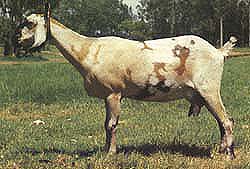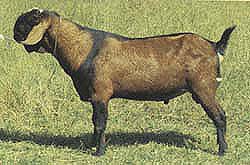
Goat breeds: Anglo-Nubian
Origin
The Anglo-Nubian is a British breed whose origins can be traced back to about 1850 when early endeavours to improve strains of British goats were made. At this time, British does were crossed with bucks imported from Africa and India, and it was not until about 1880 that the term Anglo-Nubian was first used when British and Nubian breeds were crossed.
Anglo-Nubians were introduced into Australia in the mid 1950s. Mated does were imported until 1959 when Australia’s animal quarantine regulations prevented further goat imports except from New Zealand. Due to the small number of Anglo-Nubians which had entered Australia, grading-up using Alpine breeds of does (that is Saanen, Toggenburg and British Alpine) has been necessary.
Breed characteristics
Anglo-Nubians are not heavy milk producers, although they have developed into a popular milking breed in Australia having a high average fat yield, usually over 4%. They tend to be less seasonal breeders and carry more flesh than the Alpine breeds and are recognised as dual purpose (meat and milk) animals.
The Anglo-Nubian is the best suited of the dairy goat breeds in Australia to hot conditions. They have been used in grading-up programs in many tropical countries to increase the milk and meat production of local breeds.
Anglo-Nubians are large, with does weighing at least 64 kg. The average height of the breed, measured at the withers, is 81 cm for does and 94 cm for bucks.
The ears are long, broad and pendulous. The face is convex and the forehead is particularly prominent. They have a fine tapering muzzle and flat nostrils. The backline may have a dip behind the withers and a gentle rise to the hips. The teats are often greater in length than in the Alpine breeds. Anglo-Nubians may or may not have horns at birth. The Anglo-Nubians which entered Australia did not have tassels, however they may be present in graded-up animals.
Anglo-Nubians can be any colour or combination of colours but should not show the full Swiss markings evident in the Toggenburg and British Alpine breeds.
Anglo-Nubians respond very quickly to affection and often have an unmistakable bleat.
The Anglo-Nubian doe

The high-producing Anglo-Nubian doe should also be an efficient reproducer. She should have a mild temperament, and appear alert and feminine.
The udder should be well developed not fleshy, and have a collapsed appearance and soft texture after milking. It should be round or globular, and not pendulous or ‘split’ between the halves. The udder should be carried high and well under the body. Good udder attachment is particularly important.
The teats should be distinct from the udder and moderately sized. They should be squarely placed and point slightly forward. Does with abnormal teats and udders may prove difficult to milk and should not be used for breeding replacements.
The jaw should be square (not overshot or undershot) and the teeth should be sound. The nostrils should be wide, the lips broad and the eyes set well apart. The neck should blend well into the shoulders and the chest should be broad and deep.
The body should be well developed and have good height and depth. The barrel should be deep and not fat. The ribs should be well sprung. The backline should have a very slight dip behind the withers and a gentle rise to the hips, and show no sign of weakness.
The Anglo-Nubian doe should stand and walk without dropping at the pasterns. The legs should be strong and straight without being thick, and be placed squarely under the body. The thighs should allow adequate room for the udder.
The Anglo-Nubian buck

The Anglo-Nubian buck’s ability should be gauged by his reproductive performance and the quality and performance of his offspring. The buck should have good conformation and depth of body, be masculine but not coarse in appearance and have vigour.
The testicles should be of good size, well balanced and firm. The scrotum should be well placed and allow the testes to hang away from the body (not excessively).
Only bucks which are not carriers of the gene for the beta mannosidosis condition (a lethal neurological disease of new born Anglo-Nubian kids) should be used for breeding.
Polled bucks are not generally used in breeding programs as offspring resulting from matings with polled does may be born as either intersex females or sterile males. If polled bucks are used, they should only be mated with horned does.
Further information
For breed standards contact the Dairy Goat Society of Australia.

